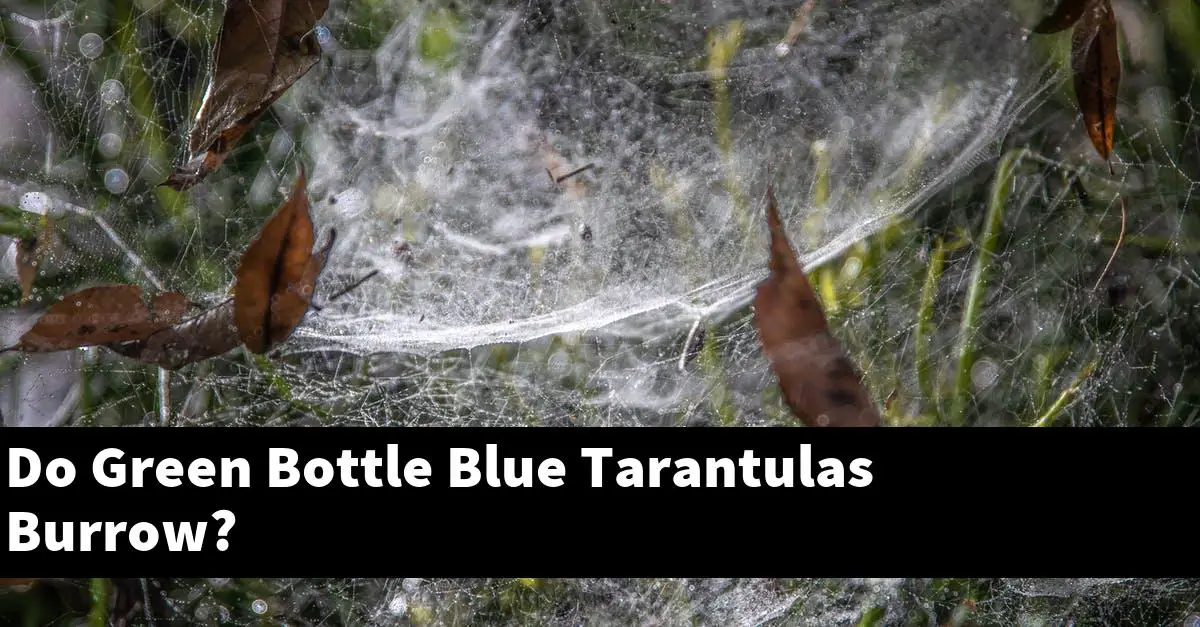Green bottle blue tarantulas are a species of tarantula that is native to South America. They are known for their vibrant blue coloration, which is why they are a popular choice for pet owners.
Green bottle blue tarantulas are not known to burrow, but they will build webs in trees or on the ground.
Table of Contents
Do green bottle blue tarantulas burrow?
It depends on the individual tarantula. Some tarantulas may burrow while others may not.
Green bottle blue tarantulas typically come from arid regions and as such, may be more likely to burrow in order to escape the heat and dryness of their natural habitat. However, this is not always the case and it really depends on the individual tarantula.
What kind of habitat do green bottle blue tarantulas prefer?
Green bottle blue tarantulas are native to the tropical rainforests of South America. They prefer a humid environment with plenty of hiding places.
A suitable enclosure for a green bottle blue tarantula should have a substrate of moist soil or coco coir, and should be decorated with plants and branches.
What do green bottle blue tarantulas eat?
A tarantula’s diet depends on its size and stage of life. Small tarantulas eat small insects, while larger tarantulas eat larger prey.
Adults also eat more frequently than juveniles. Green bottle blue tarantulas are nocturnal predators that hunt at night.
Their diet consists of small insects, such as crickets, moths, and beetles. They will also eat spiders and other small invertebrates.
How long do green bottle blue tarantulas live?
The average lifespan of a green bottle blue tarantula is between 12 and 20 years, although some individuals have been known to live for up to 30 years. They are a slow-growing species, taking between 5 and 10 years to reach adulthood.
Females tend to live longer than males, and captive-bred specimens typically have a longer lifespan than those caught in the wild. Tarantulas are generally a long-lived species, and green bottle blue tarantulas are no exception.
With proper care, they can provide their owners with many years of enjoyment.
Are green bottle blue tarantulas venomous?
No, green bottle blue tarantulas are not venomous. Tarantulas are not typically considered venomous because their fangs are not long enough to penetrate human skin.
However, some tarantulas can deliver a painful bite if they feel threatened.
How fast do green bottle blue tarantulas grow?
It can depend on a number of factors, including the species of tarantula, the conditions in which it is kept, and its diet. Generally speaking, however, green bottle blue tarantulas can grow relatively quickly, reaching full size in just a few years.
Do cobalt blue tarantulas burrow?
Yes, cobalt blue tarantulas do burrow. They are known for being very good at digging and will often make their homes in burrows that they have dug themselves.
They will also occasionally use abandoned burrows that have been made by other animals. These spiders are not shy about moving around and will often be found roaming about in search of food or a mate.
Where do GBB tarantulas live?
The gbb tarantula is a spider that is native to the rainforests of South America. They are one of the largest tarantulas in the world, with some specimens reaching over 10 inches in length.
They are also one of the most popular tarantulas among hobbyists, due to their docile nature and beautiful appearance. Gbb tarantulas typically live in burrows that they dig themselves, and can be found in a variety of different habitats including rainforests, savannas, and even urban areas.
Are green bottle blue tarantulas aggressive?
Tarantula aggression can vary greatly depending on the individual spider. However, green bottle blue tarantulas are generally considered to be more aggressive than other tarantula species.
If you are considering keeping one as a pet, it is important to do your research and be prepared to handle an aggressive spider.
Summary
There is no definitive answer to this question, as green bottle blue tarantulas can exhibit a range of behaviors when it comes to burrowing. Some individuals may dig elaborate tunnels underground, while others may simply create a shallow depression in the ground to serve as a shelter.
Ultimately, it depends on the individual tarantula and its needs/preferences.

